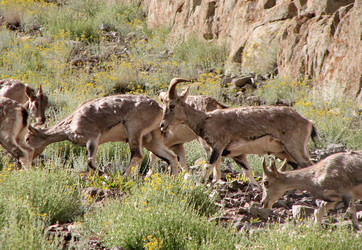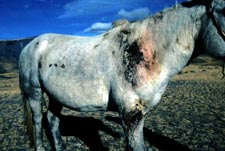Leopards are carnivores and actively hunt their prey. However, like all cats, they are opportunistic feeders, eating whatever meat they can find including carrion and domestic livestock. They are capable of killing animals three times their size but will readily take much smaller prey such as hares and birds. While unusual among most cats, snow leopards also eat a significant amount of vegetation, including grass and twigs.
The diet of the snow leopard varies across its range and with the time of year, and is dependent on prey availability. In the Himalayas it preys mostly on bharals (Himalayan blue sheep) but in other mountain ranges such as the Karakoram , Tian Shan , and Altai , its main prey consists of Siberian ibex and argali , a type of wild sheep, although this has become rarer in some parts of the snow leopard's range. Other large animals eaten include various types of wild goats and sheep (such as markhors and urials ), other goat-like ruminants such as Himalayan tahr and gorals , plus deer , boars , and langur monkeys . Smaller prey consists of marmots , woolly hares , pikas , various rodents , and birds such as the snow cock and chukar .
It is not averse to taking domestic livestock , which brings it into direct conflict with humans. Herders will kill snow leopards to prevent them from taking their animals. However, snow leopards have not been reported to attack humans, and appear to be among the least aggressive of all the big cats. As a result, they are easily driven away from livestock, readily abandon their kills when threatened, and may not even defend themselves when attacked.
Snow leopards prefer to ambush prey from above, using broken terrain to conceal their approach, and can leap as far as 14 meters (46 ft). They will actively pursue prey down steep mountainsides, using the momentum of their initial leap to chase animals for up to 300 metres (980 ft). They kill with a bite to the neck, and may drag the prey to a safe location before feeding. They consume all edible parts of the carcass, and can survive on a single bharal for up to two weeks before hunting again.
Snow leopards also eat smaller animals, especially in the summer months. Small prey include marmots, pikas, hares, other small rodents, and game birds like the Tibetan snowcock and chukor partridge.
In some areas, snow leopards also consume notable amounts of plant material, particularly during the mating season. The cats may do this to obtain specific nutrients that they need at that time of year.
Snow leopards are opportunistic predators and will take livestock (such as sheep, goats, horses, or young yaks) when domestic animals encroach into their range or when their natural prey becomes unavailable due to competition with livestock, hunting and poaching, or other causes. In some areas, snow leopards have been known to enter into corrals and kill many sheep and goats at once. Predation on domestic livestock may increase in winter, when the snow leopard's natural prey are less available and hunting is difficult because of deep snow.






